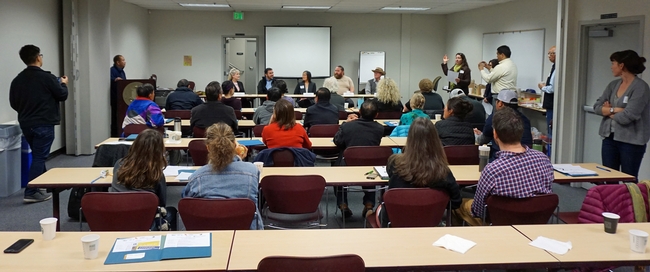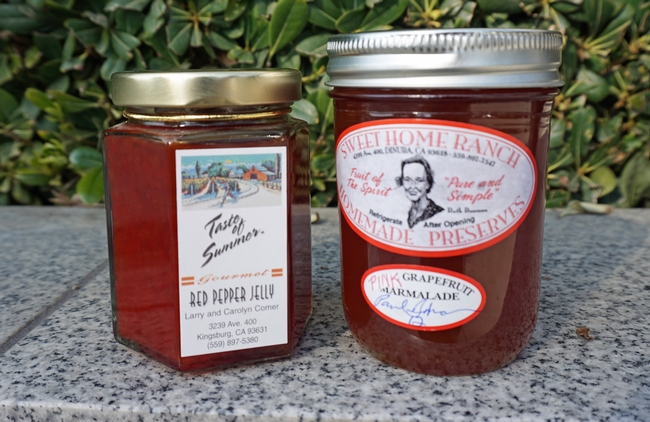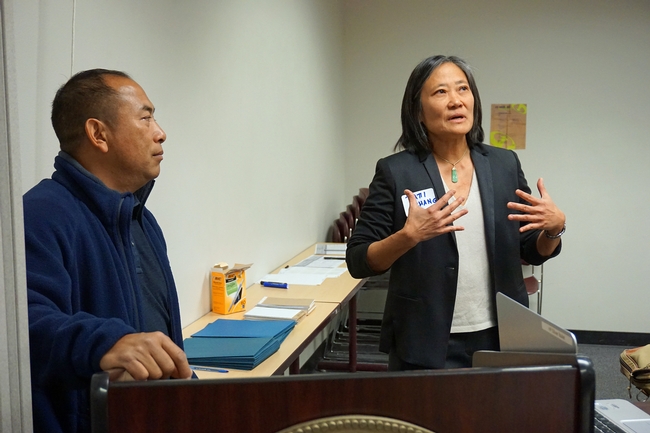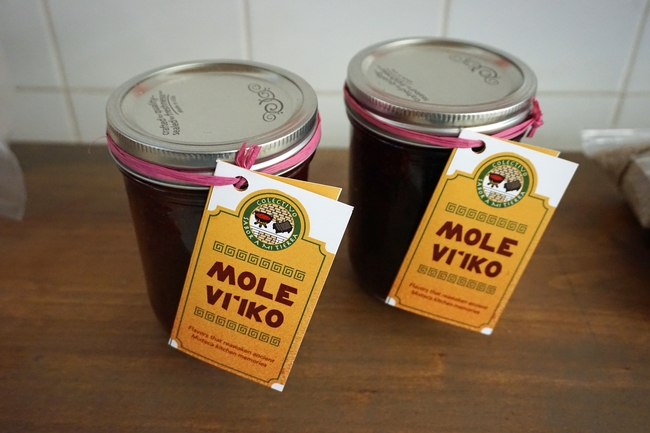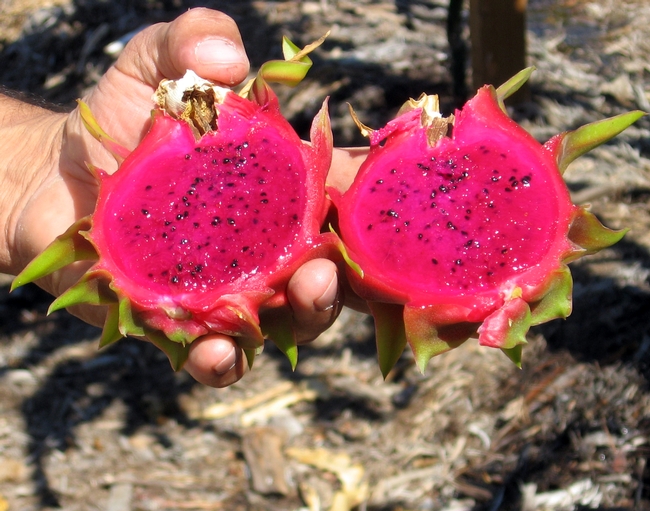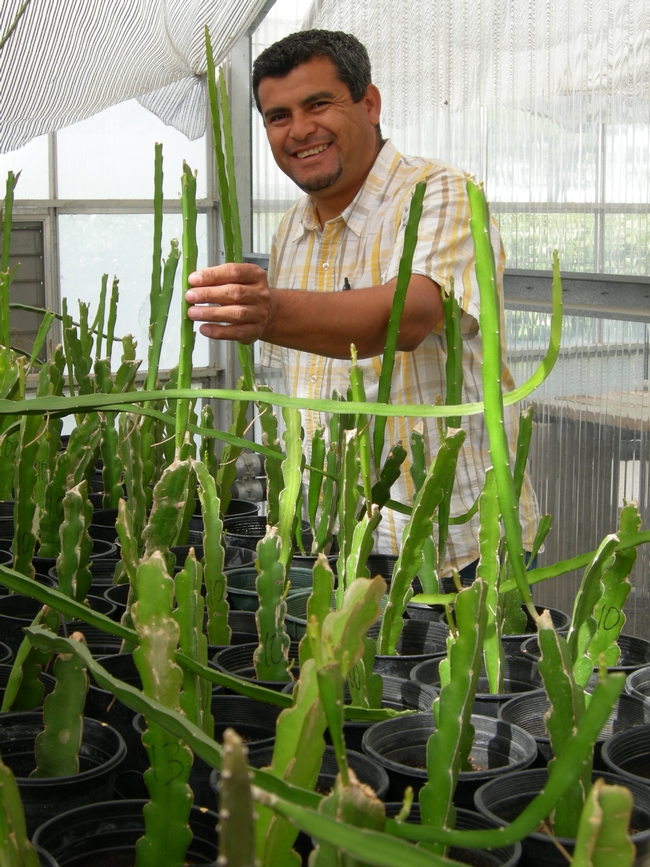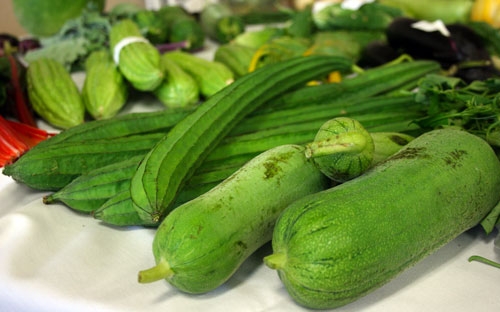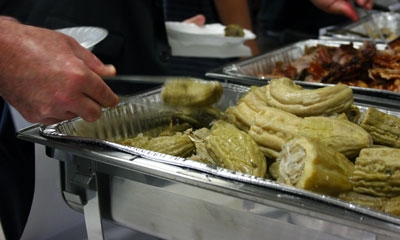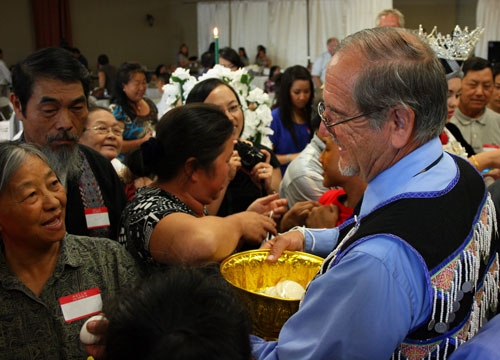Posts Tagged: small farm
Farmers can increase income by expanding small operations with creative new businesses
Farms that sell only fresh produce are dependent on buyers for markets and pricing. The UC Cooperative Extension small farms team in Fresno and Tulare counties believes farmers can earn more money by taking production a step further, by adding extra value to their products with processing, preserving and packaging the produce.
UC Cooperative Extension small farms advisor Ruth Dahlquist-Willard, the UC Sustainable Agriculture Research and Education Program, and Fresno State's Office of Community and Economic Development brought a group of small farmers together for a workshop in January to learn about resources available to help them develop value-added businesses.
“Value-added products can improve the bottom line of a small family farm by bringing in additional income and diversifying production,” Dahlquist-Willard said. “We wanted to connect beginning farmers and Southeast Asian farmers to programs that could help them develop and market value-added products from their farms.”
The value-added workshop included presentations from a farmer with a successful value-added business, government agencies and non-profit organizations. Alternative lenders such as Fresno Madera Farm Credit, who provided funding for the workshop, also presented on loans available for small-scale farms. UCCE agricultural assistant Michael Yang translated the presentations into Hmong.
Kingsburg organic farmer Paul Buxman opened the workshop with his personal journey into value-added production. Buxman's story begins in 1994 when a spring hail storm swept through his farm.
“The hail marked all my fruit. I had 100,000 pounds of plums, peaches and nectarines I could not sell. What could I do?” Buxman said. “An idea came to my head like a lightbulb. Take the fruit, cut off the scar, cook it and make jam.”
The new venture wasn't an instant success. Buxman found himself delivering unsold jam that first year to a Bay Area homeless mission, pulling up right behind a bread truck.
“Man does not live by bread alone,” he said with a laugh.
But each year he and his wife improved their product, and the market grew.
“This jam is so addictive, it's barely legal,” Buxman said. His “Sweet Home Ranch Homemade Preserves” costs $2 per jar to make, and sells for $5 each.
Buxman suggested the farmers at the UCCE workshop to try making a value-added product. The new products could be spices, food, cleaning products, handicrafts, and even experiences, such a teaching a skill.
“You have so much more to offer people than you realize,” Buxman said.
During the subsequent panel discussion, Kiel Schmidt outlined the support that Food Commons Fresno can provide. An important element is the opportunity to rent the organization's commercial kitchen to create value-added merchandise to health department specifications. Patti Chang of Feed the Hunger Foundation said her organization provides technical assistance and loans to new ventures that can carry out their mission of reducing hunger and helping people out of poverty.
“We worked with two Oaxacan women in Madera who didn't want to be field workers anymore,” Chang said. “They wanted to make a product from their culture: mole. They became a certified business, opened a bank account at Wells Fargo and opened a small restaurant in a grocery story. We helped them negotiate the lease.”
Eduardo Gonzalez of Fresno State's San Joaquin Valley Rural Development Center said his facility can help small businesses with marketing, website design and getting value-added products to market.
Dawn Goliik of the U.S. Small Business Administration said the organization can help small farmers start, grow and run businesses with training, mentoring and counseling.
“It's all free to you,” Golik said.
The UCCE small farms team also has a marketing associate, Lorena Ramos, who is available for farmers to contact regarding value-added product development.
Presentations and one-on-one consultations were offered by a variety of organizations that can loan funds, including Fresno Madera Farm Credit, Access + Capital, Northern California Community Loan Fund, California FarmLink, USDA Farm Service Agency and Valley Small Business Development Corporation.
The workshop ended with a presentation on California's Cottage Food Law, which allows residents to process and prepare foods in their own home kitchens to sell to the public. Some of the home-prepared products the law permits are jams, jellies, cookies, cakes and fudge, dried fruit, vegetables and spices. A complete list of approved foods is on the state website.
The Cottage Food Law is for businesses with a gross annual income below $50,000, which have no more than one employee (not including household members).
“There is no charge, just paperwork to fill out,” said Matthew Gore with Fresno County Environmental Health. “This isn't difficult, and we're here to help you with the forms.”
Dahlquist-Willard said an important part of her UC Cooperative Extension program is the connections she and Yang can help farmers make with the myriad services available to them.
“We encourage small farmers to contact us in our Fresno office,” she said.
Contact information:
Ruth Dahlquist-Willard, (559) 241-7515, rdahlquistwillard@ucanr.edu
Michael Yang, (559) 241-7523, myang@ucanr.edu
Lorena Ramos, (559) 241-7524, mlramose@ucanr.edu
Farmers learn, connect, tour and taste in Sacramento
Running a small-scale farm or ranch isn't easy; it requires hard-learned skills, innovative marketing and a supportive community. Farmers and ranchers from all over California will join with farmers' market managers, educators, small farm advocates, and some of the most creative of Sacramento's Farm to Fork chefs at the California Small Farm Conference, held this year at the DoubleTree Hotel in Sacramento from March 5 to March 8, 2016.
For three days, about 400 attendees will join workshops, explore with field courses, network with colleagues and enjoy a few social events. The now-annual conference was started by the UC Agriculture and Natural Resources (UC ANR) Small Farm Program in 1982 as a unique opportunity for small-scale farmers to learn, network and grow their businesses. UC ANR specialists, advisors and staff continue to contribute to the conference as members of the board of directors and as educators presenting science-based information at workshops and field courses.
The conference offers workshops in five different themes. This year, among many other speakers, UC Cooperative Extenison (UCCE) small farms and agricultural economics advisor Ramiro Lobo will lead a workshop on risk management strategies for farm enterprise diversification; Alda Pires, UCCE Cooperative Extension specialist in urban agriculture and food safety, will speak at a workshop on food safety on bio-diversified small-size farms and the FSMA Produce Safety Rule; and UCCE advisor Paul Vossen will teach about both growing cider apples in California and irrigation management for olive growers in a time of drought. In addition to UC and other educators, each of the 25 workshop sessions includes the perspective and practical experience of at least one small-scale farmer or farmers market manager.
Sunday, March 6, features all-day field courses and short courses, giving participants a chance for deeper understanding and multiple perspectives as they explore their choice of four different topics. Two of the courses this year will be led by UC ANR educators or staff.
For the on-site short course, "Starting a SUCCESSFUL Specialty Food Business," Shermain Hardesty, a UCCE specialist in the Department of Agricultural and Resource Economics at UC Davis (and leader of the UC Small Farm Program) teams up with Linda Harris, a UCCE specialist in Food Safety and Microbiology at UC Davis, Dan Sullivan, a specialty food business expert and specialty food producers, Jason Poole of Preservation & Co. and Courtney Smith of Bloomingcamp Ranch. UCCE Agritourism Coordinator Penny Leff will lead a field course named, "Direct Marketing: Farmers' Markets, Farm Stands, U-Pick and Wine Tasting," that will visit and learn from some of Sacramento region's expert practitioners of these various direct marketing venues.
Sacramento region food and beverage fans are invited to attend the "Taste of Sacramento" Tasting Reception on Monday, March 7, from 5:30 to 7:30 p.m. The Tasting Reception is the culinary and social highlight of the California
Small Farm Conference and showcases the beautiful bounty of the region. Attendees will taste the creations of Sacramento's best Farm-to-Fork chefs, brewers, winemakers and artisan food and beverage producers. Local farmers, including Riverdog Farm, Full Belly Farm, Heavy Dirt Farm, Dragon Mushrooms, and others are providing meat and produce for the chef's cook-off contest (you vote for your favorite) featuring chefs from Mulvaney's, Magpie Cafe, Localis, Federalist Public House, the Culinerdy Cruizer, and Sacramento's Food Literacy Project. Proceeds ($50 ticket - purchase here or at the door) support the Small Farm Conference scholarship program.Online registration for the conference has now closed, but on-site registration is welcome! For more information, see the California Small Farm Conference website, or phone (888) 712-4188. See you there!

Photo of Guido Frosini, True Grass Farms, by Janae Lloyd, a winner of the farm conference 2015 photo contest.
California drought and the fate of the state’s beloved berries
Will berries taste like colored Styrofoam if water supplies for farmers are cut? Or will a reduction in irrigation only intensify their flavor?
To find out, farm advisors around the state are comparing strawberries, blueberries and blackberries grown under four irrigation regimes – one that reflects the normal practice, one half the normal amount of water, one 75 percent of normal, and one that is 25 percent more than normal. The studies are being conducted in Santa Clara, San Luis Obispo, San Diego and Fresno counties.
“We’re doing this because of the water issue in California,” said Richard Molinar, UC Cooperative Extension advisor in Fresno County. “We’re in drought mode. We want to look at ways farmers can cut back the amount of water they are using and still have good tasting berries.”
Molinar recently brought samples of strawberries grown at the UC Kearney Agricultural Research and Extension Center in Parlier to the Vineyard Farmers Market in Fresno and invited patrons to share their preferences. Strawberry tasters were asked to evaluate the fruits’ appearance, flavor and texture. The advisors will aggregate information from taste testing done on berries from all the research sites.
The research will go beyond consumers’ preferences. Beth Mitcham, UCCE specialist in the Department of Plant Sciences at UC Davis, will evaluate the fruit grown under different irrigation regimes in the laboratory. Mitcham’s research will determine the amount of sugar, the sugar-acid ratio and the amount of antioxidants in the fruit and how these are affected by increasing or decreasing the usual amount of irrigation water.
The study is funded with a specialty crops grant from the California Department of Food and Agriculture awarded to the small farm program under the direction of Shermain Hardesty, UC Cooperative Extension specialist in the Department of Agricultural and Resource Economics at UC Davis.
See video of the strawberry tasting here:
You should taste it fresh
Question: What exotic fruit has been named as a flavor in Starburst candy, Ice Breakers gum, SoBe beverages, Vitamin Water drinks, Bacardi rum and even Axe body spray?
Answer: Dragon fruit. (Hylocereus spp.)
So while many of us may have tasted products that flaunt its name, have you ever sunk your teeth into a fresh dragon fruit?
If you want to try one, you may be in luck because now is the peak harvest season in Southern California for this subtropical cactus fruit with the fire-breathing name — also known as pitahaya. And it just so happens that growing and eating fresh dragon fruit is what Ramiro Lobo, UC Cooperative Extension farm advisor for San Diego County and the Small Farm Program, is most interested in.
Lobo says he’s known about pitahaya since he was a kid, but his professional interest was rekindled when the enthusiasm of the Rare Fruit Growers group intersected with an ongoing quest to find crops that are more water-efficient for the region.
“Wherever you can grow Hass avocados, you can grow dragon fruit,” he said. “And it uses less water than avocados or any other orchard crop that we grow in San Diego.”
Though this used to be a fruit found only rarely in specialty stores, Lobo says that is changing.
“We’ve seen the market expanding. We’re seeing it in high-end restaurants in Los Angeles and Las Vegas,” he said. “Supply is very sketchy right now, but growers who are selling direct at farmers markets are getting $7-8 per pound. Hardly any other fruit today is bringing that kind of money.”
One other clue that the U.S. market for this “artichoke from Mars” (as one LA Times writer described it) is expanding? Imports of the fruit have been growing from Vietnam, with perhaps 600 tons imported in 2010. And the USDA is currently working through the processes that could allow imports from Mexico, Thailand and Central America too.
While Lobo doesn’t sound too worried about competing with imported dragon fruit, he does hope your first taste of fresh dragon fruit is indeed very fresh.
“We cannot compete with Vietnam fruit for price, but we can definitely compete for quality,” he said. “The challenge is that a lot of people are exposed to dragon fruit, but the fruit quality is lousy. It’s a very sensitive fruit, so if you put it in a container and send it across the ocean for 10 days, it’s not going to be as good. But people who get exposed to a good variety keep buying it.”
In California, it is estimated that about 200 acres are planted in pitahaya, with anywhere from 400 to 1,000 acres planted nationwide.
Lobo oversees approximately 500 dragon fruit plants at the UC South Coast Research and Extension Center in Irvine. He is currently working to set up an irrigation trial for pitahaya, to better evaluate its water requirements. He is also working to test out different trellis systems, comparing hedge versus orchard systems for this fruiting cactus.
The UC South Coast Research and Extension Center is also where the pitahaya field day was held recently. Lobo said questions from the day’s 100 or so participants sounded like more growers are getting serious about growing pitahaya commercially, with more technical questions and an interest in disease, rodent and pest management.
“The bar has been raised, and [some of those questions] even put us in a bind because without the research, it is kind of hard to answer them,” he said.
In the meantime, Californians and marketing companies will probably continue to find new secondary uses for this fruit’s juice, pulp and name: Lobo says he’s seen wines made with dragon fruit and organic yarn dyed naturally with that fiery pink flesh.
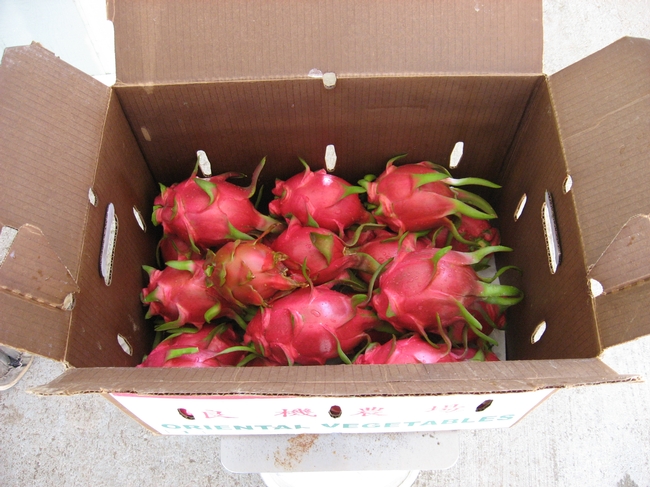
Pitahayas, as packed at a small farm in San Diego. (Photo by Shermain Hardesty)
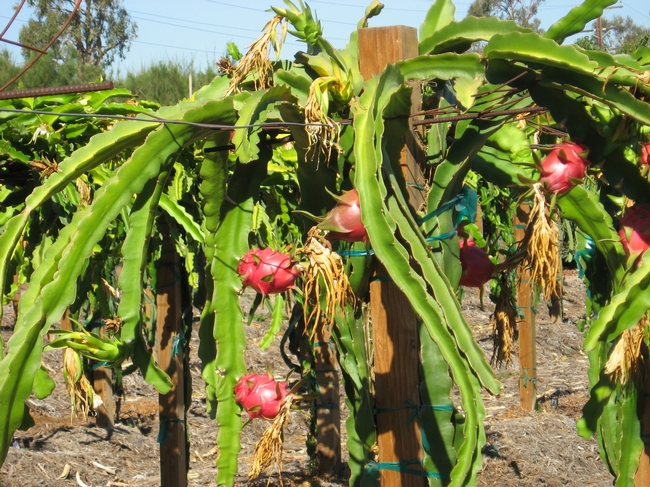
At UC South Coast Research and Extension Center, the dragon fruit plants are currently in an orchard system, though new trellis trials will soon be under way. (Photo by Shermain Hardesty)
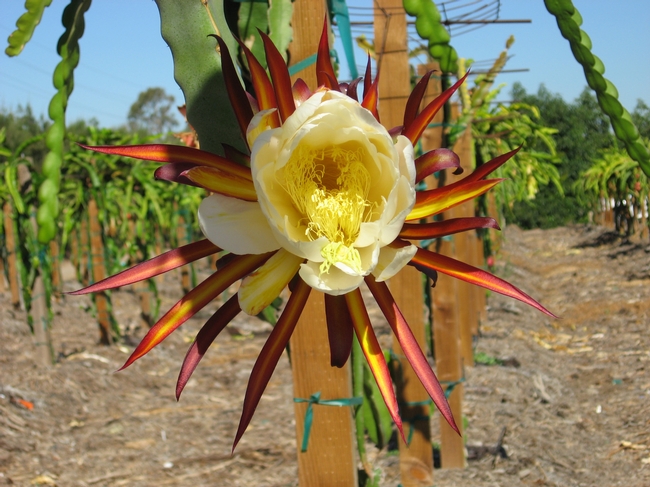
Pitahaya blooms at UC South Coast Research and Extension Center. (Photo by Shermain Hardesty)
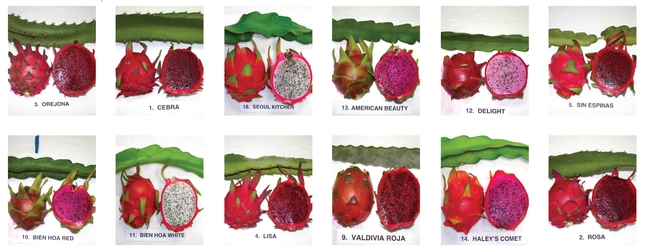
Colors of ripe pitahaya flesh can vary between red, fuschia, pink and white.
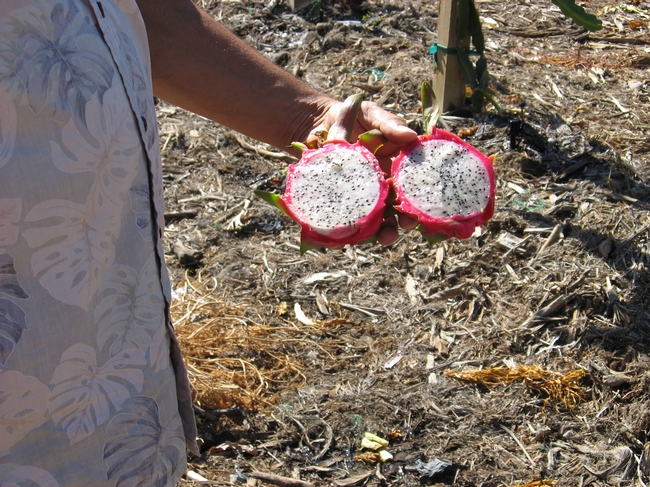
Irvine Field Station white flesh pitahaya
Put down that zucchini! Pick up the ... bittermelon?
Welcome to August. Are you tired of summer squash yet?
If your dinners have been overflowing with zucchini recently (like mine have), now might be a great time to try new varieties of otherwise familiar vegetables.
One of the farm advisors I work with has long touted some varieties of "Asian vegetables" as more flavorful than their traditionally "American" cousins. Here in the U.S., vegetable varieties like these are more likely to be grown by farmers — and sold to customers — who have close ties to Asian immigrant communities. Richard Molinar, UC Cooperative Extension farm advisor for Fresno County, works frequently with Hmong farmers and says that he now prefers Hmong cucumber and Japanese eggplant to the varieties you might find in most California supermarkets.
After years of hearing Molinar's claims, I finally had a chance to try some of these new-to-me Asian vegetables during lunch at the Hmong Specialty Crops and Medicinal Herbs conference.
Presenters in the morning talked about crops such as sinqua, luffa (photo above has fresh luffa, in angled and smooth varieties), moqua, snake gourd, bittermelon and donqua — all of which are cucurbits, in the gourd family with other squashes and melons. Other Asian vegetables common in some specialty markets include leafy greens and tender shoots from chayote, amaranth, bittermelon, pumpkin, okra leaf, yam leaf, yucca and sour leaf plants. Discussions at the conference focused on these and other specialty crops, including ways to eat them.
"Maybe we need a recipe to teach customers how to buy these new crops," said Chukuo Thao, CEO of National Hmong American Farmers, who alternated between English and Hmong while speaking at the conference.
Some of the vegetables and herbs discussed at the conference were highlights of that day's lunch. The menu included a slushy Hmong cucumber drink, purple sticky rice, salsa made with cherry tomatoes, stir-fried mustard greens with pork skin, Hmong herbal chicken soup and steamed bittermelon stuffed with turkey.
But how did it taste? The stuffed bittermelon was what I was most looking forward to trying. The dish was delicious and wow, was it bitter! That is one appropriately named vegetable. Speakers at the conference suggested bitterness is frequently associated with medicinal qualities in Hmong cuisine.
Not all of the lunch dishes were bitter, of course. The cucumber dish was refreshing and very sweet, a dish with eggplant was spicy, and the mustard greens were salty and pungent. Many of the dishes were also made with lemongrass; Fresno County is where most of the nation's lemongrass comes from, according to Molinar in a recent article from the California Ag Network.
Curious about other Asian vegetables? Check out the Small Farm Program's guides to Asian vegetables, along with tips for farmers about how to grow and sell these niche varieties.
Question: The Small Farm Program has a lot of information about different vegetable varieties, but I'm still finding new vegetables to try. What are some of your favorite Asian vegetables?
P.S. While the conference was my first chance to taste bittermelon, Richard Molinar and Gus Schumacher (former USDA undersecretary) were being honored by Hmong community members for their long-time support of Southeast Asian refugee farmers. The two men were each given Hmong names in a special ceremony.


